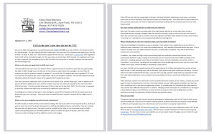 See Mike Petrilli's post on the Fordham "Gadfly" about how we should focus more on making the teachers we have more effective, rather than continuing to search for the elusive "higher quality" teacher through strategies like eliminating tenure, pay for performance, or alternative certification.
See Mike Petrilli's post on the Fordham "Gadfly" about how we should focus more on making the teachers we have more effective, rather than continuing to search for the elusive "higher quality" teacher through strategies like eliminating tenure, pay for performance, or alternative certification. While I agree with the thrust of his argument, his suggestion that one way of doing this through "augmenting technology" is bogus. No study has shown that technology improves teacher effectiveness or raises student achievement.
Instead, teachers themselves say that the best way to improve their effectiveness by far is to reduce class size. See the recent national survey of first year teachers from Public Agenda, called "Lessons Learned" .
76% of teachers overall said that reducing class size would be "a very effective" way of improving teacher quality, and 78% of teachers who work in high needs schools. 21% of teachers said reducing class size would be "effective", for a total of 97% -- far outstripping every other strategy mentioned, including :
Increasing teacher salaries (57%), increasing professional development opportunities (54%), making it easier to terminate unmotivated or incompetent teachers (41%), requiring new teachers to spend time under the supervision of experienced teachers (35%) requiring graduate degrees in education (21%), requiring teachers to pass tough tests of their knowledge ot their subject (21%), tying salaries to principal or colleagues assessment (15%) tying rewards and sanctions to student performance (13%), eliminating tenure (12%), reducing regulations for teacher certification (8%), and relying more on alternative certificaiton (6%)..
(In each of the categories I have put in parentheses the percent who said this would be a "very effective" way to to improve teacher quality.)
By the way, these views about the effectiveness of reducing class size to improve teacher effectiveness are shared by more experienced teachers and most principals as well.
See this 2006 public agenda survey of teachers and school administrators, "Is Support for Standards and Testing Fading."
"If the public schools finally got more money and smaller classes, they could do a better job." 88% of teachers agreed with this statement, and 85% of superintendents and principals, far outstripping any response.
Compare how many teachers, superintendents and principals agreed with this statement: "More testing and higher standards will ensure kids will master the skills they need": 1% (teachers), 7% (supers); 10% (principals).
If we really respected the opinions and views of the professionals who work in our schools, we would do everything in our power to reduce class size.















6 comments:
What a great moment of reading blogs.
There are a few options that are generally not considered.
How many would you guess have agreed that "reducing the number of different classes taught?" would increase teacher effectiveness?
"Reducing the total number of classes taught?"
"Increasing teacher input in curriculum choice, textbook choice, etc?"
Jonathan
Every time China and Korea and Singapore are brought up as examples of stellar education results, think about the fact that their class size is 40-60 pupils.
Yes, 40-60 homogeneous Chinese or Korean Students per class might be Ok, but we are not homogeneous, we are a melting pot of nationalities and that makes all the difference.
If we had a less difficult population and everyone parents and children were on the same page so to speak, the children could deal with a larger class size. It still wouldn't be the best learning environment since each child couldn't possibly get enough individual attention. Using Asian countries as role models for Americans is like saying dogs should be role models for cats. We are different here. We speak from many different languages, cultures and viewpoints. We will never be like them. We have different values and culture. How can we ever be like them? We need to face the problem here. We need individual attention for each child and we can only do this by lowering class size.
If we had a less difficult population and everyone parents and children were on the same page so to speak, the children could deal with a larger class size. It still wouldn't be the best learning environment since each child couldn't possibly get enough individual attention. Using Asian countries as role models for Americans is like saying dogs should be role models for cats. We are different here. We speak from many different languages, cultures and viewpoints. We will never be like them. We have different values and culture. How can we ever be like them? We need to face the problem here. We need individual attention for each child and we can only do this by lowering class size.
Post a Comment